- ホーム
- > 洋書
- > 英文書
- > Literary Criticism
基本説明
This analysis of pity and fear within fifth-century tragedies provides insights into the ethical and social implicaitons of the emotions.
Full Description
Scholars have often focused on understanding Aristotle's poetic theory, and particularly the concept of catharsis in the Poetics, as a response to Plato's critique of pity in the Republic. However, this book shows that, while Greek thinkers all acknowledge pity and some form of fear as responses to tragedy, each assumes for the two emotions a different purpose, mode of presentation and, to a degree, understanding. This book reassesses expressions of the emotions within different tragedies and explores emotional responses to and discussions of the tragedies by contemporary philosophers, providing insights into the ethical and social implications of the emotions.
Contents
Introduction; Part I. Theoretical Views about Pity and Fear as Aesthetic Emotions: 1. Drama and the emotions: an Indo-European connection?; 2. Gorgias: a strange trio, the poetic emotions; 3. Plato: from reality to tragedy and back; 4. Aristotle: the first 'theorist' of the aesthetic emotions; Part II. Pity and Fear within Tragedies: 5. An introduction; 6. Aeschylus: Persians; 7. Prometheus Bound; 8. Sophocles: Ajax; 9. Euripides: Orestes; Appendix: catharsis and the emotions in the definition of tragedy in the Poetics.






